
Wat Pho
Wat Pho is one of the oldest temples of Bangkok and one of the most famous sights of Thailand. The temple was built in 1793 on an older temple called Wat Potaram (Temple of the Bodhi Tree). After the Wat Pho was expanded to become the royal temple in 1801, it was given the name Wat Pra Chetuphon by Rama I. However, the name did not prevail because the people continued to call the temple Wat Pho. Rama III. expanded the monastery and built a community college for Thai medicine. That is why Wat Pho is also famous for its massage therapists who offer foot massages in the temple.
The biggest attraction of Wat Pho is the 46 m long Reclining Buddha. The huge sculpture consists of plastered bricks covered with gold leaf. The 15 m high figure is hollow. The life of Buddha was depicted on the soles of the feet with mother-of-pearl inlays. The feet symbolize the entrance to nirvana.
Also worth seeing is the Bot (The Bot is the central ceremony hall of the temple) with a meditating golden Buddha. Don't miss the covered walkways around the Bot, with around 400 beautiful Buddha statues. Another popular photo motif is the black stone phallus Lingam, which is said to ensure fertility.
Between the hall with the Reclining Buddha and the Bot is a square with a garden, here are the 4 royal chedis. Chedis (stupa) are bell-shaped towers that taper upwards and usually contain a relic. The four chedis were built by the kings Rama I-IV and contain valuable Buddha figures.
In addition to all the sights, Wat Pho is also a prime example of Thai architecture and one of the most beautiful temple complexes in the country.
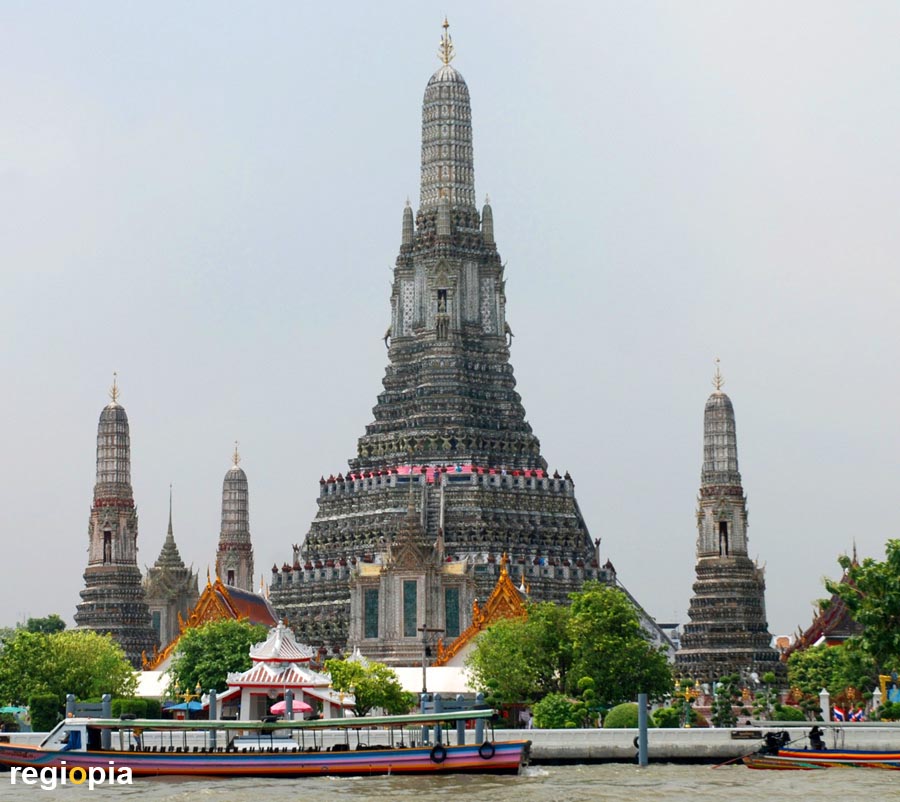
Wat Arun
The 70 m high Prang (tower) of Wat Arun is the most visible landmark of Bangkok. The "Temple of Dawn" is in Thonburi on the other bank of the Chao Phraya. There used to be a Chinese temple and the Royal Palace, which was built by King Taksin in 1780. The Buddhist temple Wat Arun was built in 1800 by Rama II and was completed by Rama III. (1824-1851).
Wat Arun consists of 5 towers, the middle tower Phra Prang is over 80 m high and symbolizes the holy mountain Meru. The four smaller towers symbolize the four oceans. The temple is clad with colorful porcelain fragments and many figures. These include yakshahas (guards), kinnaris (bird girls), garudas (bird people), monkeys and even a few Europeans. You can climb the tower on steep stairs and look across the river to the opposite bank.
Around the main temple of Wat Arun are smaller side temples with Buddha figures and bell towers.
How to get there
Near the Wat Pho is the ferry station Tha Tien, from here boats go directly to Wat Arun on the other side of the Chao Phraya.
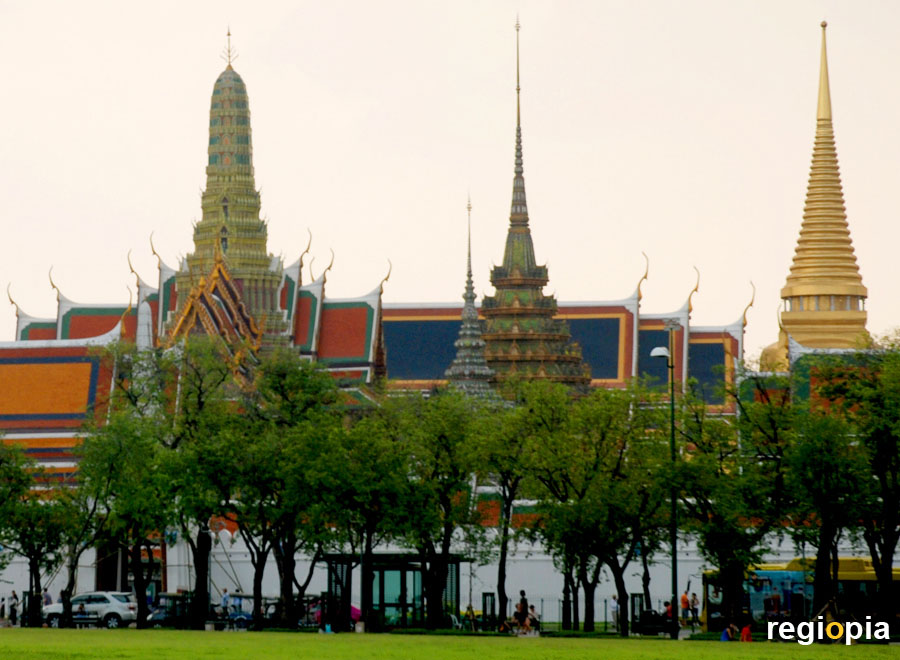
Grand Palace and Wat Phra Kaeo
The King's Palace and Wat Phra Kaeo Temple together form a complex of architecture and handicrafts that is unique even in Thailand. The Royal Palace was built in 1782 by Rama I, who made Bankok the capital and built his new center of power on this site. The palace district is surrounded by a 2 km long wall. Within the district are the royal palace, representative audience halls, the royal temple Wat Phra Kaeo and ministries. The royal family now lives in the Chitralada Palace north of the city center. The former palace district is now a museum and is only used occasionally for representative events and for coronation.
The main entrance is at Sanam Luang Park in the north. First you come to the temple district, which was only used by the king. Here are golden chedis, shrines for individual deities, a stone model of Agkor Wat (belonged to Thailand at that time) and many towers. Everything is so close together that it is impossible to look at each building individually. Then there are the masses of visitors and the many enchanting sculptures that stand in front of the buildings. In order to avoid total sensory overload, you should look for a somewhat quieter corner and let this madness of shapes and colors work its magic on you.
The most important sanctuary in Thailand is Phra Ubosot (Bot). The main hall of Wat Phra Kaeo houses the Emerald Buddha. A 75 cm high jade statue, wearing a robe made of gold threads. The Emerald Buddha should not be photographed. The statue originally stood in a temple in Chiang Mai, but then moved to Luang Prabang in Laos. After a campaign, the Thais were able to retake the Emerald Buddha.
The Grand Palace (Phra Chakri Maha Prasat) is the former royal palace. The building was designed by an Englishman and has a marble Renaissance facade and a Thai roof with golden turrets. The Grand Palace is flanked by the throne hall Amarinda Vinichai (left) and the audience hall Dusit Maha Prasat (right). The filigree amphorn phimok pavilion, which is located on the northwest corner of the square, is also very beautiful.
Free shoulders, shorts and skirts, leggings and flip-flops are prohibited in the palace.
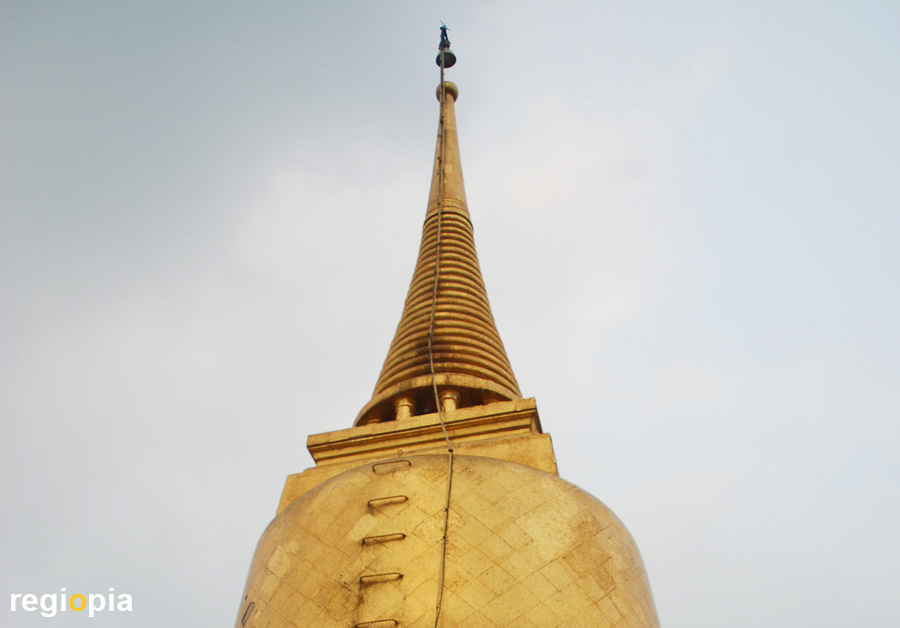
Golden Mount
The approximately 76 m high artificial hill "Golden Mount" was built around 1800 as a cremation site for deceased nobles. Around 1899 a chedi for a Buddhist relic was built on the summit and a monastery with 2 bots at the foot of the hill. Over 300 steps lead to the surrounding terrace, from which one can enjoy one of the most beautiful views over Bangkok. Bells and Buddhist chants create a very relaxed atmosphere on the Golden Mount in the evening, when the sky turns pink and the surrounding temple roofs reflect the last rays of sunshine.
In November, the temple festival in honor of the relic rises on the Golden Mount. Food stalls are set up and various theater groups show a colorful program.
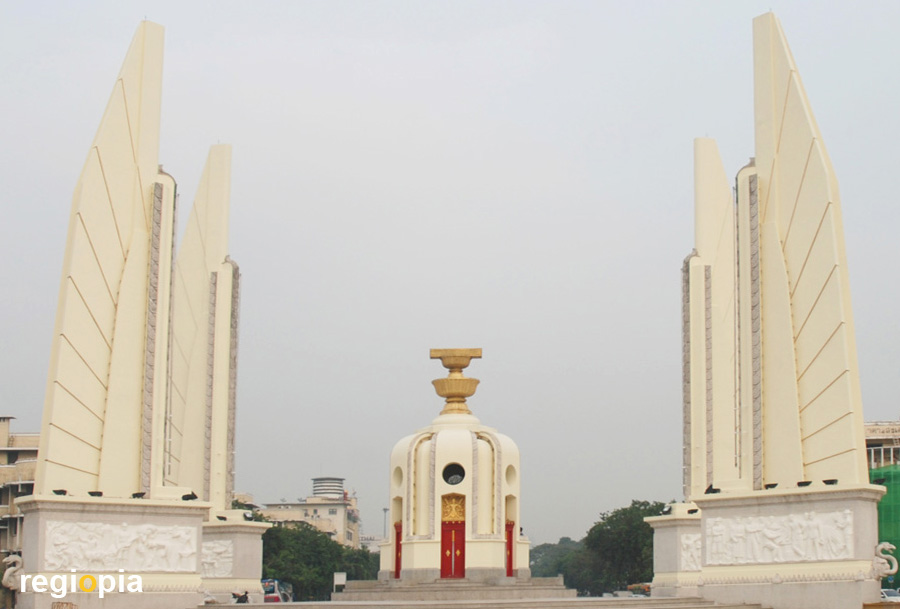
Democracy Monument
The Democracy Monument was built in 1939. The occasion was the transition of Thailand to a constitutional monarchy. The Siamese Revolution was a military coup that led to the introduction of democracy in 1932. The monument stands on a green roundabout in the middle of Ratchadamnoen Klang Road. North of the Democracy Monument is km zero for the Thai road network.
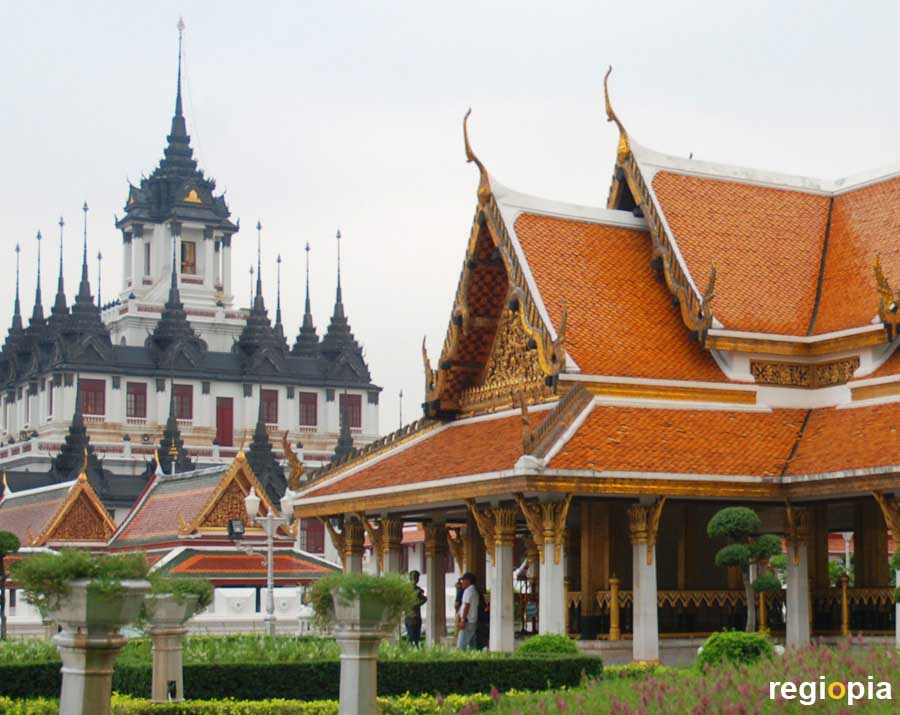
Wat Ratchanatda
The temple complex Wat Ratchanatda was built in 1846 by King Rama III. for his niece Sommanad Wattanawadi, who later became the wife of King Rama IV. The temple is famous for the Loha Prasat temple tower. There are 37 iron chedis on the three-tier structure. For this reason, Wat Ratchanatda is also called the "Iron Temple". The Loha Prasat was built on the model of the Lovamahapaya temple in Sri Lanka. Rama III. saw this temple while studying on the island. In the meantime, the 37 chedis have been gilded, which makes the temple look more splendid but also not that special any more.
Officially, the temple is called Wat Ratchanatdaram Worawihan, but that is too long even for the Thai people and that's why it is simply called Wat Ratchanatda. On the green square in front of the temple, a monument to King Rama III. was erected.
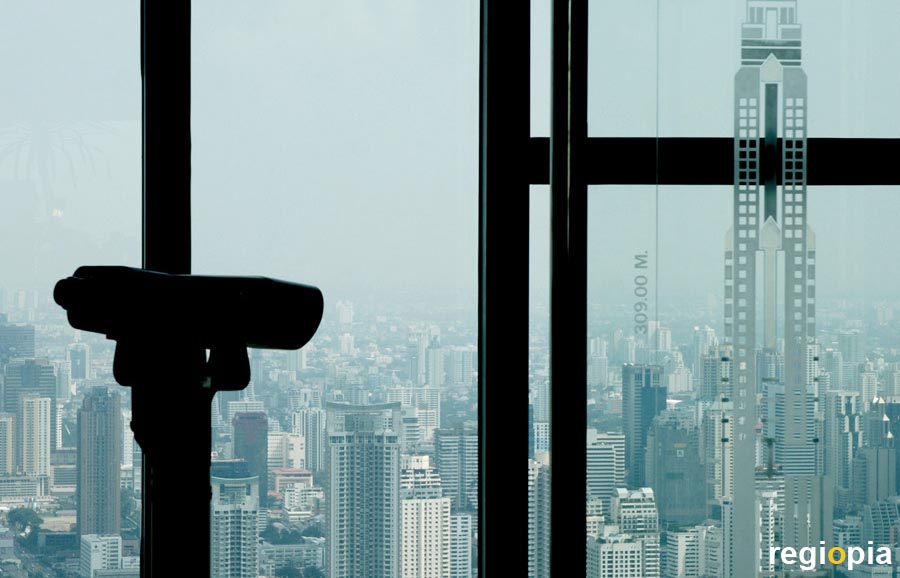
Baiyoke II Tower
The 304 m high skyscraper is the second tallest building in Thailand. From the observation deck of the "Baiyoke II Tower" you can see the whole city (on a clear day). The tallest skyscraper in Bangkok ist the 313 m high "Maha Nakhon Tower", built in 2016 by german architect Ole Scheeren.
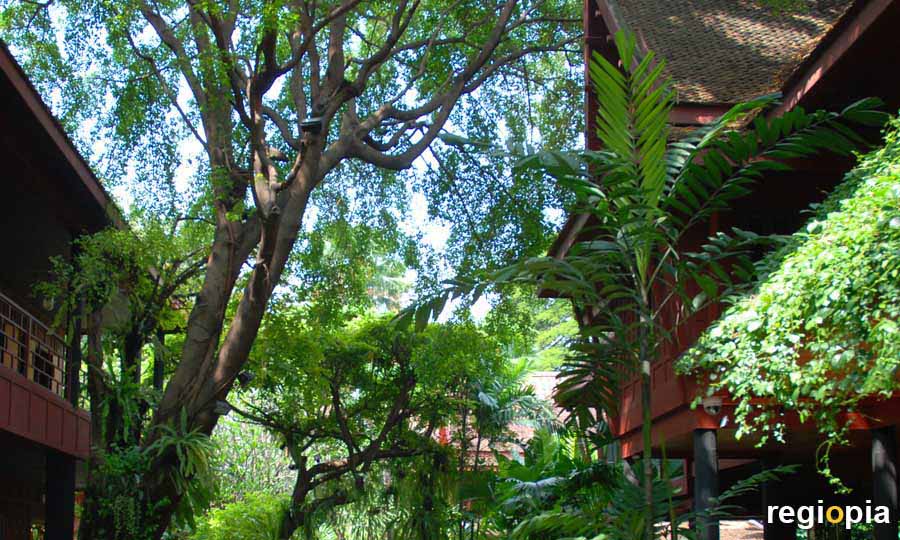
Jim Thompson House
The American architect Jim Thompson revived the Thai silk weaving in 1945. He marketed the silk abroad, helping to preserve traditional handicrafts. Jim Thompson was an adventurer who is said to have a big heart for the Thai women. There are many rumors surrounding him, including that he was said to have worked for American intelligence. Jim Thompson disappeared in the mountains of Malaysia in 1967.
In Bangkok, he built teak houses in the traditional style of Thai architecture. The houses stand on a clong (canal) in a beautiful garden. Works of art and Buddhist statues are exhibited in the houses. At the entrance there is a shop where you can buy silk fabric products. Jim Thompson House is an enchanting oasis in the middle of the city.
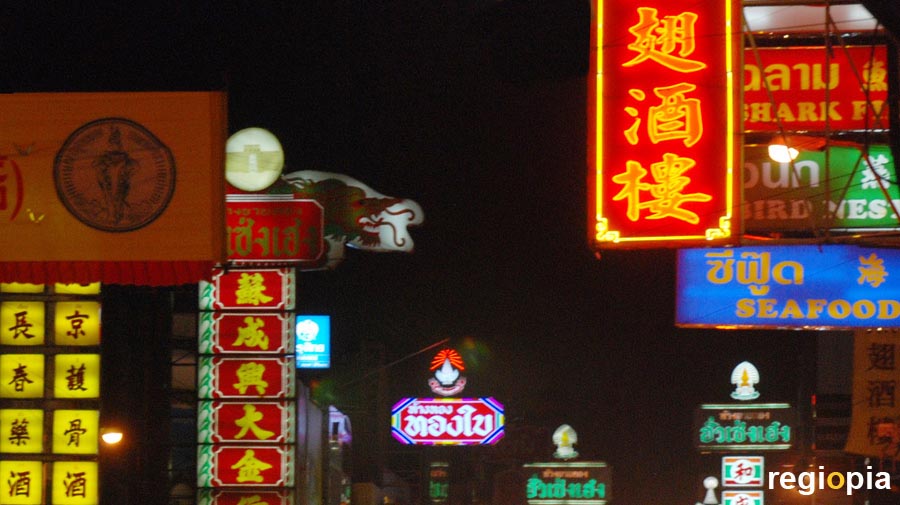
Bangkok China Town
China has always been one of Thailand's most important trading partners. As in many other countries in the region, Chinese merchants settled near the port. Bangkok's Chinatown also emerged from such a settlement, which was moved here for the construction of the palace. Chinese shops and restaurants characterize the picture with colorful neon signs around Yaowarat Road. Those who have never been to China can get an impression of how things are in the land of dragons and steamed dumplings. China Town is loud and full of people, especially in the evening, the streets and restaurants fill up quickly.
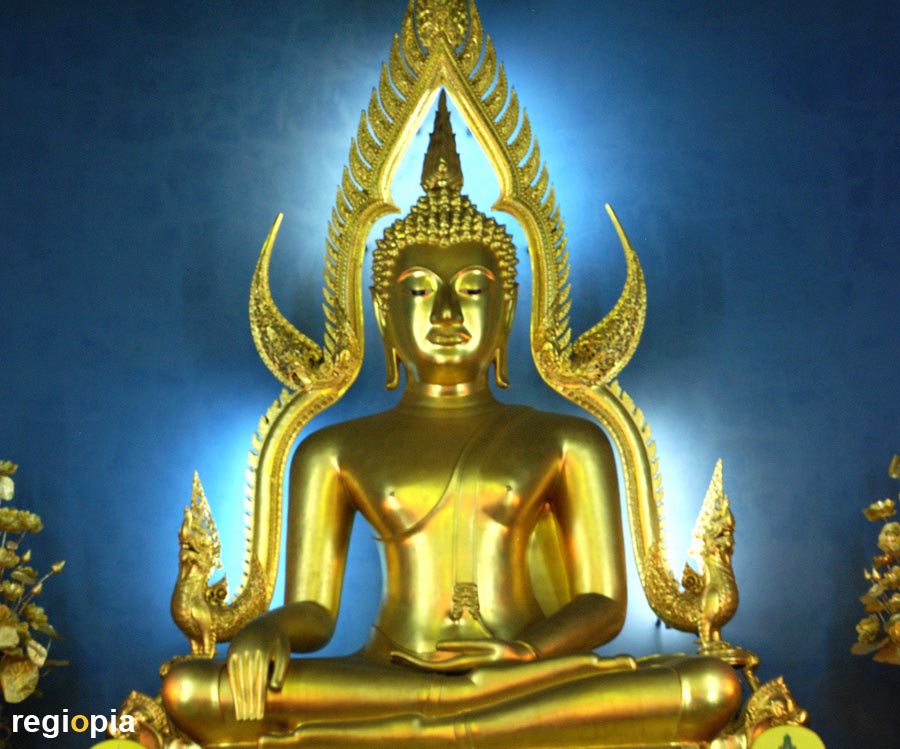
Wat Benchamabophit
Wat Benchamabophit, also known as "Marble Temple" because of the white Carrara marble, was built in 1899 by King Rama V. The king also known as Chulalongkorn (RamaV.) lived for some time as a monk in the temple.
The Wat Benchamabophit impresses with its over 50 very beautiful Buddha statues, which represent different styles. Some Buddhas are from Japan, Myanmar and Sri Lanka. In the bot of the temple is one of the most beautiful, seated Buddha statues in Thailand. It is a replica of the Buddha from Wat Phra Si Rattana Mahathat from Phitsanulok in northern Thailand. The ashes of RamaV are in the base of the golden Buddha.
You can sit on the floor in front of the Golden Buddha and meditate, just sit with the others and listen to the sound of the sky.
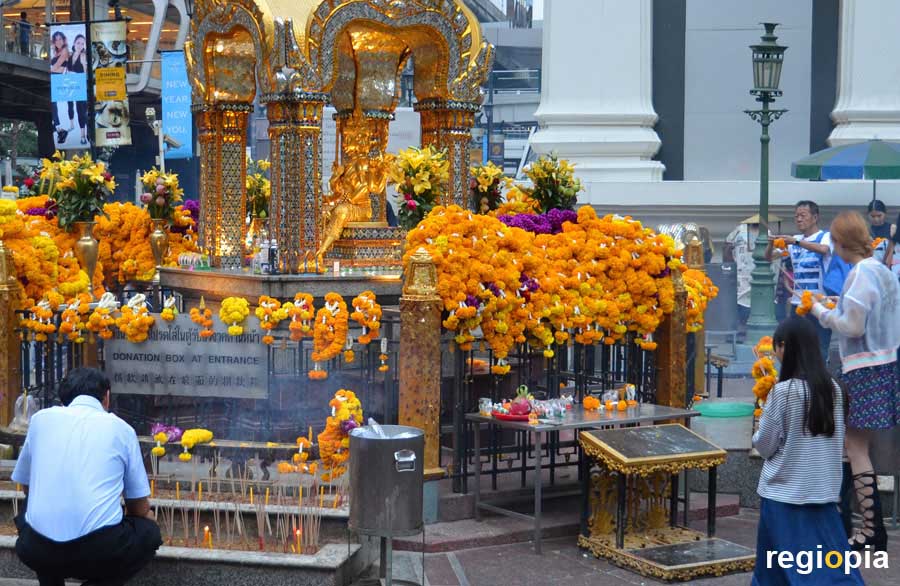
Erawan Shrine
The Hindu "Erawan Shrine" was built for Brahma in 1956 after a series of accidents occurred during the construction of the Erawan Hotel. The four-faced Brahma is adorned with flowers and is very popular among the people of Bangkok. The sculpture was destroyed in 2006 by a Muslim with a hammer, he was lynched on the spot. A bomb detonated here in 2015 and killed 20 people. The Hindu shrine is a prime target of radical Islamists.
According to Indian mythology, Erawan is an elephant with 33 heads. The white elephant is Indra's mount and has the ability to bring rain. The Erawan Shrine was named after the Erawan Hotel, so you don't see the white elephant here, but the god Brahma. In Thai, the shrine is called San Phra Phrom (Brahma Temple). Brahma is considered a god of good luck and protection, he is also worshiped by Thai Buddhists.
Map sights in Bangkok
ads
Travel Guide Bangkok
Welcome to Bangkok
Bangkok is the capital of Thailand with over 8 million inhabitants. At first glance, Bangkok looks like a giant Moloch of highways, elevated railways and high-rise buildings. At second glance, the city is still a huge Moloch. Most of the sights are around Wat Pho with the great Reclining Buddha. This temple is also the most famous sight of Bangkok. Even if some taxi drivers claims that the temple is closed, ignore them. Many taxi drivers have their own perception of absolute truth. In general the temple is open between 8:00 a.m. and 6:30 p.m.
Tip: In the meditation halls, the feet should not point towards the Buddha.
ads
ads


